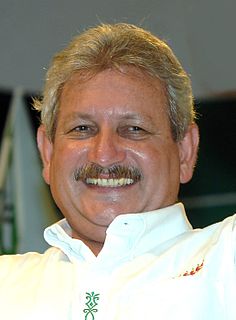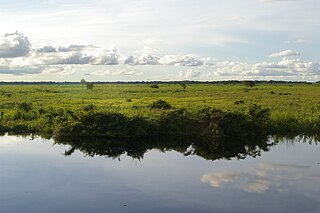
The politics of Bolivia takes place in a framework of a presidential representative democratic republic, whereby the president is head of state, head of government and head of a diverse multi-party system. Executive power is exercised by the government. Legislative power is vested in both the government and the two chambers of parliament. Both the Judiciary and the electoral branch are independent of the executive and the legislature. After the 2014 election, 53.1% of the seats in national parliament were held by women, a higher proportion of women than that of the population.

Elections in Bolivia gives information on elections and election results in Bolivia.

A constitutional referendum was held in Bolivia on 25 January 2009, postponed from the initially planned dates of 4 May 2008 and then 7 December 2008. Drafted by the Constituent Assembly in 2007, the new constitution was approved in the referendum according to an exit poll by Ipsos Apoyo for La Razón and ATB, a Bolivian television network. Furthermore, it required early elections to be held on 6 December 2009.

Rubén Armando Costas Aguilera is a Bolivian politician and the current governor of Bolivia's Santa Cruz department for the Truth and Social Democracy (VERDES) party. In 2013, he founded the Social Democrat Movement party to participate in the 2014 presidential and parliamentary election. Previously he served as prefect on behalf of the Autonomy for Bolivia party. He was one of the nine Bolivian prefects directly elected in the general elections of 2005. This election was the result of several negotiations and large, peaceful public demonstrations in Santa Cruz. The 1967 Bolivian constitution said that prefects can only be appointed by the president, but because of the negotiations and popular desire, the Bolivian Congress approved Law 3015 to formalize the prefect election process.

The Media Luna or Media Luna Ampliada refers to a group of four departments – Santa Cruz, Beni, Pando, and Tarija – in Bolivia which became the geographic area of opposition to the national government led by Evo Morales and the Movement for Socialism (MAS).

The Bolivian Constituent Assembly, convened on August 6, 2006 in Sucre, with the purpose of drafting a new national constitution by December 14, 2007; extended from the original deadline of August 6, 2007. The Assembly approved the new Political Constitution of the State on 9 December 2007. It was put to a national referendum held on 25 January 2009, and went into force on 7 February 2009.
Events from the year 2007 in Bolivia

A referendum to approve the autonomy statute of Santa Cruz Department of Bolivia was held on 4 May 2008. The vote resulted from strains between the Prefecture of Santa Cruz and President Evo Morales. The referendum was declared illegal and unconstitutional by the National Electoral Court. Final results from the referendum showed that 85.6% of participating voters supported autonomy. Abstention rates were 37.9%. Partisans of the Movement for Socialism called for a boycott of the vote, and the Guarayo, Guaraní, Chiquitano, Ayoreo, Yuracaré-Moxeño indigenous peoples were urged to reject holding the vote in their territories.

A vote of confidence in President Evo Morales in the form of a referendum was held in Bolivia on 10 August 2008. The vote was held to determine whether Morales, Vice President Álvaro García Linera, and eight out of nine departmental Prefects should stay in office. Morales received more than 67% support and six of the eight prefects were returned. The prefects of Cochabamba Department and La Paz Department were defeated and had to face re-election.

An autonomy referendum was held in Tarija Department in Bolivia on 22 June 2008, following the autonomy referendum held in Santa Cruz Department on 4 May 2008 and the autonomy referendums held in Beni Department and Pando Department on 1 June 2008. The referendum was approved with over 80% in favour, though most supporters of President Morales did not vote.

The 2008 unrest in Bolivia began with protests against President Evo Morales and calls for greater autonomy for the country's eastern departments. Demonstrators escalated the protests by seizing natural gas infrastructure and government buildings. Violence between supporters of Morales and opponents resulted in at least 30 deaths.
Leopoldo Fernández Ferreira is a Bolivian politician. A member of Social and Democratic Power (PODEMOS) Fernández was Prefect (Governor) of the northern Bolivian department of Pando from 2006 to 2008.

The Bolivian general election, 2009 was held on December 6, 2009, following a constitutional referendum held on 25 January 2009. Voters elected:
The Porvenir massacre was a deadly ambush in the early hours of September 11, 2008, allegedly organized by Prefectural authorities of the Bolivian Department of Pando, as part of a civil coup d'état against the government of Evo Morales by members of the right-wing civic movement. As a result of the ambush, at least 12 indigenous protesters of the municipality of El Porvenir died that day.

The 2010 Bolivian regional elections were held on 4 April 2010. Departmental and municipal authorities were elected by an electorate of approximately 5 million people. Among the officials elected are:
The first Bolivian judicial election was held on 16 October 2011. The national vote was held to elect magistrates to serve on the Supreme Tribunal of Justice, the Plurinational Constitutional Tribunal, the Agro-environmental Tribunal and members of the Council of the Judiciary. It was originally scheduled to be held on 5 December 2010, but officials of the National Electoral Court and of the MAS majority in the Plurinational Legislative Assembly delayed it. The vote will be the first time that a Latin American country directly elects its highest judicial officials.

The Presidency of Evo Morales began on January 22, 2006 when Evo Morales was inaugurated as the 80th President of Bolivia, following his victory in the 2005 general election, where he won 53.7% of the vote, defeating Jorge Quiroga, Samuel Doria Medina, and several other candidates. Morales increased taxation on the hydrocarbon industry to bolster social spending, emphasising projects to combat illiteracy, poverty, racism, and sexism. Vocally criticizing neoliberalism and reducing Bolivia's dependence on the World Bank and International Monetary Fund, his administration oversaw strong economic growth while following a policy termed "Evonomics" which sought to move from a liberal economic approach to a mixed economy. Scaling back U.S. influence in the country, he built relationships with leftist governments in the Latin American pink tide and signed Bolivia into the Bolivarian Alliance for the Americas. Attempting to moderate the left-indigenous activist community, his administration also opposed the right-wing autonomist demands of Bolivia's eastern provinces. Winning a recall referendum in 2008, he instituted a new constitution that established Bolivia as a plurinational state and was re-elected in 2009. His second term witnessed the continuation of leftist policies and Bolivia's joining of the Bank of the South and Community of Latin American and Caribbean States; he was again reelected in the 2014 general election.













